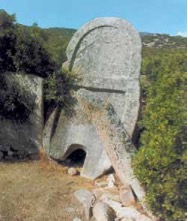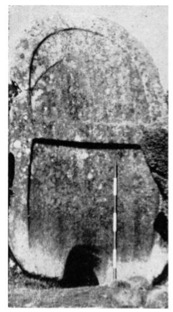The arched stele of the tomb of Thomes
The collective megalithic burial of S'Ena 'e Thomes, a dolmen-type structure with walls made of large slabs planted knife-wise in the ground and a roof of side by side horizontal slabs, is a remarkable example of Nuraghic funerary architecture whose construction dates back to the Middle Bronze Age 1 (about 1600-1500 B.C.).

At the centre of the semi-circular space of the exedra where the funeral rites were held, there is still in situ (fig. 2) the most interesting element of the burial site, the arched stele, which symbolically represents the door to the kingdom of the dead.

In 1967 Giovanni Lilliu, the archaeologist who discovered the Nuraghic mansion of Barumini, mentions and illustrates the unique and unusual granite stele of Thomes, of which he provides details concerning its considerable size (fig. 3).

Formed by a single sub-oval block, it is 3.65 metres high, 2.10 wide, 40 cm thick and weighs approximately 7 tons; it shows a profiled arch, surrounded by a frame in relief and a transverse listel (fig. 4).

At the bottom there is the small squared door with rounded corners connected to the burial chamber. The right pillar of the stele is shorter than the other one and leans on a carved block, supported by a pile of small stones. There is also a side recess which embellishes the stele; the slabs planted knife-wise into the ground at the sides of the stele were worked so as to completely match it.
Bibliografia
- CASTALDI E., Tombe di giganti nel Sassarese, in Origini, III, 1969, p. 134.
- CONTU E., Il significato della stele nelle tombe di giganti, in LO SCHIAVO F (a cura di), Collana Quaderni. Archeologia e conservazione, Sassari 1978, tav. II,5.
- GUIDO F., Tomba di giganti di Thomes - Le monete, in Dorgali. Documenti archeologici, Sassari 1980, pp. 101-102.
- LILLIU G., Rapporti architettonici sardo-maltesi e balearico-maltesi nel quadro dell’ipogeismo e del megalitismo, in Atti del XV Convegno di Storia dell’architettura (Malta, 11-16 settembre 1967), Roma 1970, p. 115, p. 116 - fig. 26, p. 166 - nota 86.
- LO SCHIAVO F., Notiziario, in Rivista di Scienze Preistoriche, XXXIII, 1978, p. 450.
- MANUNZA M.R., Dorgali (Nuoro). Censimento archeologico: relazione preliminare, in Nuovo Bullettino Archeologico Sardo, I, 1984, pp. 371-73.
- MANUNZA M.R., Dorgali. Monumenti antichi, Oristano, 1995, pp. 111-112, figg. 144-148.
- MORAVETTI A., Tombe di giganti nel Dorgalese, in Dorgali. Documenti archeologici, Sassari 1980, pp. 79-88.
- MORAVETTI A., Le tombe e l’ideologia funeraria, in La civiltà nuragica, Milano, 1990, pp. 120-168.
- MORAVETTI A., Serra Orrios e i monumenti archeologici di Dorgali, Sardegna Archeologica. Guide e itinerari, 26, Sassari 1998, pp. 75-78, figg. 61-64.
- MORAVETTI A. (a cura di), Carbonia-Fonni, in La Sardegna. I Tesori dell’Archeologia, La Biblioteca della Nuova Sardegna, vol. 3, Sassari 2011, pp. 90-91.

 VR
VR